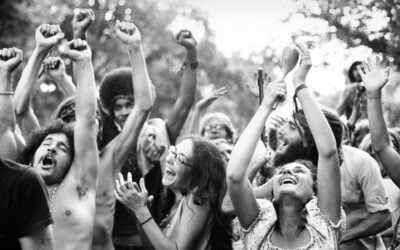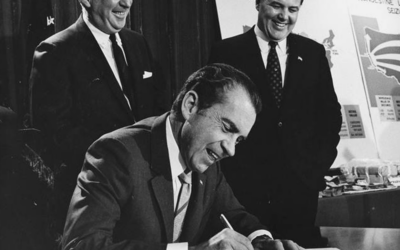Vipers & the Gage: Cannabis in the Jazz Age
“Come on, sisters, light up on these weeds and get high.”
-Cab Calloway, “The Man From Harlem” (1932)
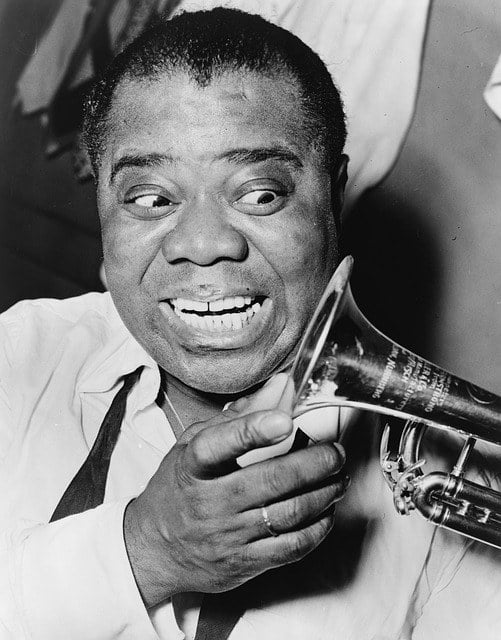
Here’s Louis “Pops” Armstrong, jazz legend. You’ve seen dozens of photos of King Louie, eyes gleefully bugged-out as he worked through a blistering trumpet solo.
Did you know he was probably high in all of them?
We’re now a century removed from the Roaring Twenties, and we’ve forgotten that jazz, the soundtrack to the era, was then was the most radical style to ever hit the music scene.
Jazz took traditional orchestral arrangements, cranked them up, and laced them with ragtime rhythm. The hyper snares and swinging beats of jazz numbers drove young couples to the dance floor, and it drove their parents crazy.
US Ambassador Henry van Dyke said that jazz was “…not music at all. It’s merely an irritation of the nerves…” The New York Times (falsely) reported that Siberian villagers used jazz music to scare away wild bears at night. And Harry J. Anslinger, the man who successfully lobbied for the US Congress’s cannabis ban, despised jazz (mainly due to ethnicities of those who played it). He called it “Satanic” and denounced it as an erosion of all that was good in America.
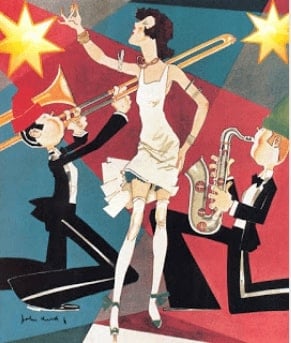
The Jazz Age of the 1920s coincided with the Prohibition — a time when, ironically, alcohol was nationally-banned, but cannabis was not. You could get a joint at any big-city “tea pad” (marijuana bar) for 20 cents. Jazz players who used cannabis were called “vipers,” named so for the hissing sound produced by taking a big draw.
A young Louis Armstrong became a viper himself when, in the early 20s, he traveled from his native New Orleans to Chicago to seek music gigs. His search didn’t last very long; he was quickly hired by a local band. Louis had learned to play the trumpet as a young boy in reform school, and then he spent his teens playing shows every night aboard steamboats on the Mississippi River. He put in the hours, and though he was barely over the age of twenty when he pulled up in Chicago, he’d already developed a genius for improvisation.
After dark, the vipers played in downtown speakeasies, but they eschewed booze in favor of cannabis. It gave them a creative kick without the hangover. They called musicians who drank between sets (and grew sloppy as the night wore on) “bottle babies.”
Clarinetist Mezz Mezzrow, an Armstrong contemporary, said, “We were on another plane compared to the bottle babies (…) we liked things to be easy and relaxed, mellow and mild (…) while their tones became hard and evil, not natural, soft and soulful.”
Armstrong first tried “the gage” (one of the many name street names for cannabis at the time) during intermission at a performance at the Savoy Ballroom.
“It’s a thousand times better than whisky”
Armstrong later explained to his biographer.
“We always looked at pot as a sort of medicine, a cheap drunk and with much better thoughts than one that’s full of liquor.”
Louis partook in the gage nearly every day from that point on, and if anything, his new habit only accelerated his rise. Throughout the 20s & 30s, he appeared in more than sixty Hollywood films, and his radio show brought his wild solos and fast-paced, gravelly scatting into homes around the country. Armstrong had made it to the A-list… as a Black man in Jim Crowe-era America.
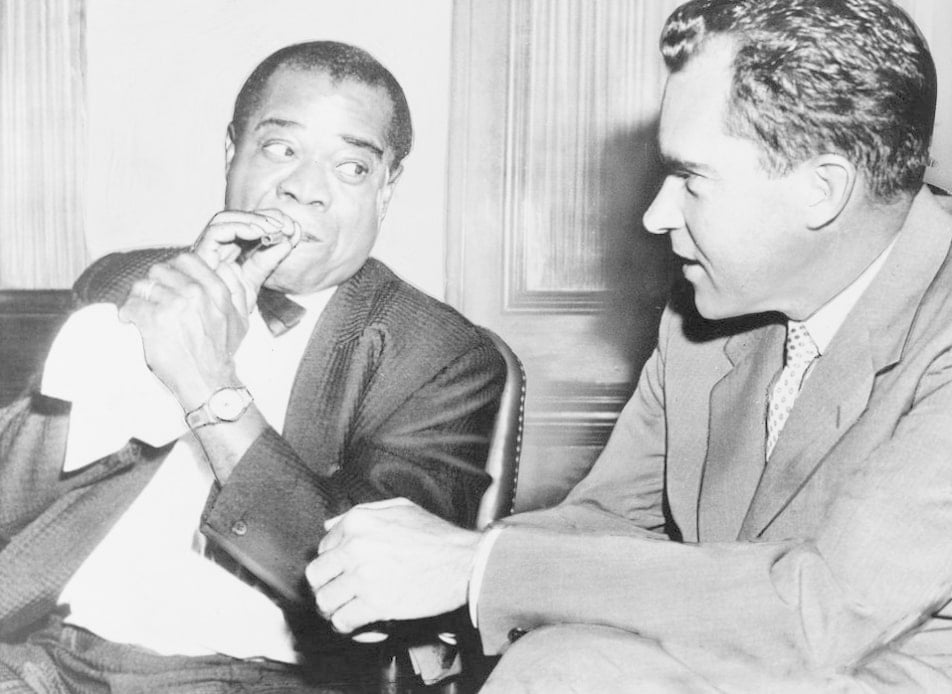
(Go here for an amazing story of then-Vice President Richard Nixon helping Armstrong smuggle cannabis through airport customs in 1953).
In 1931, when cannabis had already been made illegal in California, Armstrong was caught with a roach in an LA parking garage before a performance. But the arresting officer, a fan of Armstrong’s radio show, let him finish his gig before taking him downtown. Louis spent nine days in county jail before being released. (He was sentenced to six months in prison, but the sentence was suspended).
Armstrong continued to use cannabis at all of his shows, even after it was outlawed nationally in 1937. Before a performance? A stick of the gage. In the studio, about to record? The same. It was part of the vipers’ process. They used it to bond as a band, and to loosen up before riffing.
“…the fairly small community of jazz musicians… constantly practiced together, brainstormed together, and smoked marijuana together,” Peter Webster noted in a 2001 study titled Marijuana and Music. “The herb was often used as a stimulus to creativity, at least for practice sessions, many such as Armstrong praising its effects highly.”
“If ya ain’t got in ya, ya can’t blow it out,”
Louis would say.
Vipers commonly shouted out cannabis in tracks such as Cab Calloway’s “The Reefer Man” and Stuff Smith’s “If You’se a Viper.”
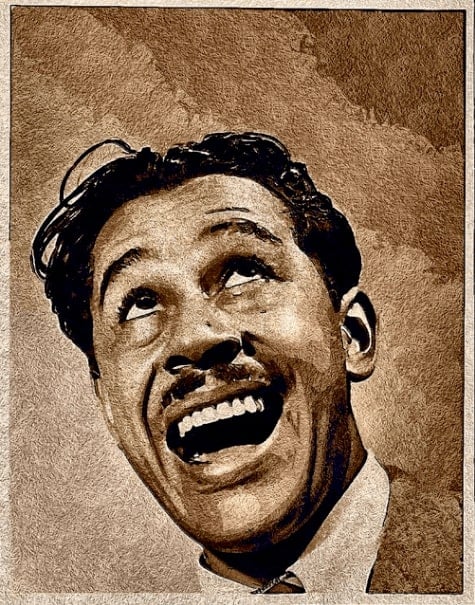
Cab Calloway, one of Armstrong’s fellow vipers.
(Prhbtd.com put together a list of the best jazz “cannabis” songs from the 1930s — the last decade cannabis was still legal throughout most of America)
Jazz songs were driven by a bouncy, staccato tempo. It was the pop of its day, and the first style of music that made middle America move. And there’s evidence that cannabis was a catalyst for this groundbreaking new sound.
Most of us know that cannabis can slow things down and put you in a relaxed, zen-like state. Now, let’s extrapolate — how would a professional musician operate in this space?
Dr. James Munch, a Temple University pharmacologist and an associate of Harry Anslinger’s, said the following when he testified before Congress on the psychoactive effects of cannabis:
“…the chief effect [of marijuana] as far as [jazz musicians] were concerned was that it lengthens the sense of time… therefore they could get more grace beats into their music… if you’re using marijuana, you’re going to work in about twice as much music between the first note and the second note.”
While attempting to present cannabis as a vice of crazed, spastic degenerates (read: jazz artists), Munch inadvertently detailed its creative potential. The “time-slowing” effects of cannabis changed the jazz vipers’ perception — allowing them to slip on and off beat and transcend the time signatures on their sheet music. This resulted in the wild, bouncy, foot-stomping jazz we know today.
Cannabis also made performers less self-conscious, and prone to experimentation. Music psychologist Daniel J. Levitin wrote in his book The World in Six Songs that “THC… is known to disrupt short-term memory. What this does is keep you in the present, allowing you connect more fully with the music as time “stands still”…people stoned on pot live for each note, completely in the moment.”
Was every jazz star a viper? Of course not. Duke Ellington, one of the era’s elite pianists, said that he “never smoked anything without a label on it.”
But imagine if there hadn’t been any gage at the Savoy Ballroom for Louis Armstrong to try when he was starting out in Chicago. He’d, of course, still have gone on to be the Louis we remember. But who knows how many killer solos we’d have missed out on?
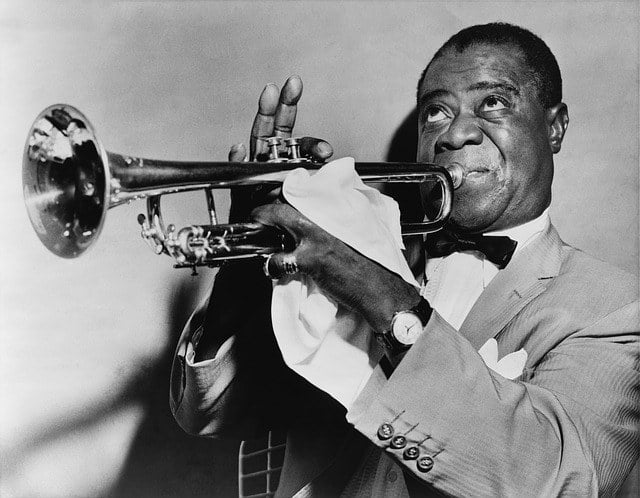
Go here to see some of the mind enhancements of a cannabis high. And check out last week’s article on the history of cannabis in visual art.
Related Articles
The Rise of American Cannabis Culture
The Rise of American Cannabis Culture The modern cannabis culture is still young. After all, it was completely illegal throughout the US until 1996, when California voted to permit medicinal cannabis. And here in Colorado, we’ve only been able to operate since 2014. ...
The History of Cannabis Criminalization
It’s an unprecedented time in cannabis culture. Many of us can buy some flower or an edible at a corner dispensary right now - which would have been unthinkable in our parent’s time. As legalization progresses in the US and across the globe today, it’s...
The Story of Your Favorite Rock Stars’ Cannabis Arrests
Many of our greatest creatives and musicians have used cannabis as a creative aid - and they did so at a time when consumption was still illegal in nearly every part of the globe. With the extra scrutiny that comes with life under the spotlight, this meant that...
